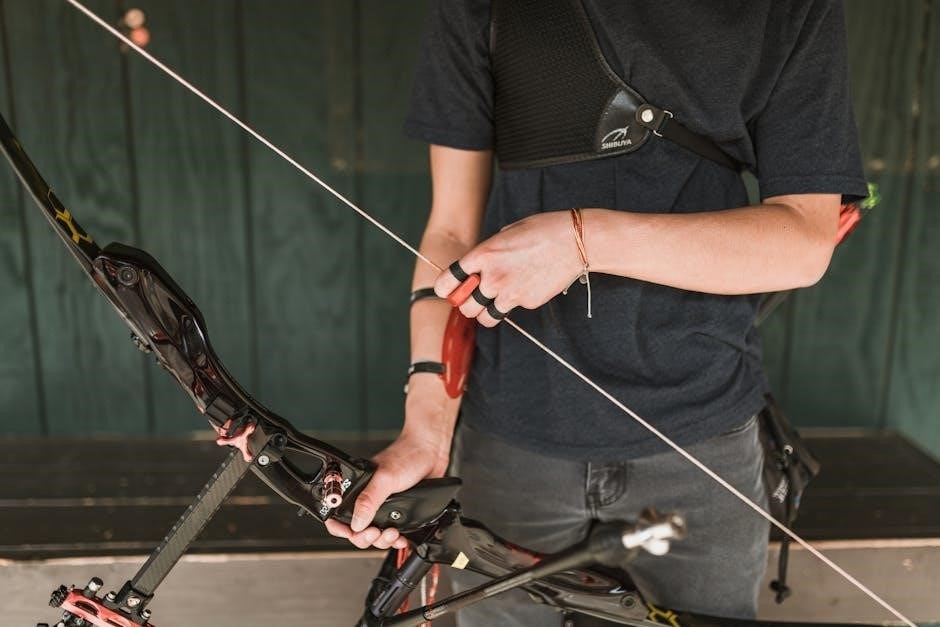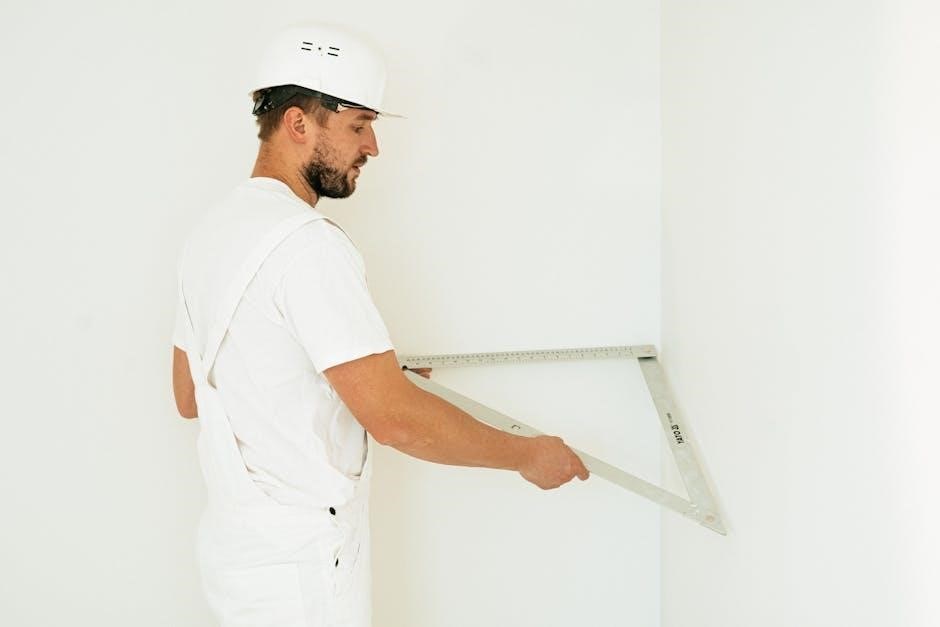
sarmiento brace instructions
The Sarmiento brace is a functional orthopedic device used to stabilize fractures of the humerus, providing circumferential compression to immobilize and support the bone during healing․ It is designed to limit motion while allowing early functional use of the arm, promoting recovery without surgery․ This guide offers step-by-step instructions for proper application, care, and use of the brace to ensure optimal results and comfort during the rehabilitation process․

How to Apply the Sarmiento Brace
Start by placing the cotton undersleeve on your arm for comfort․ Position the brace shell on your shoulder, ensuring proper alignment with the fracture site․ Fasten the straps beginning at the elbow and moving upward, securing Velcro closures firmly․ Tighten the long strap under your healthy arm, wrapping it around your back and through the buckle․ Ensure a snug fit to maintain stability and promote healing․ Always follow specific fitting instructions provided by your healthcare provider․
Initial Fitting and Adjustment
The initial fitting of the Sarmiento brace is crucial for effective fracture stabilization and patient comfort․ Begin by placing a cotton undersleeve on the affected arm to prevent skin irritation․ Position the brace shell over the fracture site, ensuring it aligns correctly with the humerus․ Secure the straps starting at the elbow and work upwards, tightening each Velcro closure to achieve a snug fit․ The long strap should be wrapped under the healthy arm, around the back, and through the buckle, ensuring proper compression․ Adjustments may be necessary to accommodate swelling or discomfort․ Your healthcare provider will guide the fitting process, ensuring the brace is firm enough to immobilize the fracture without restricting blood flow․ Proper alignment and fit are essential for optimal healing and to avoid complications․ Regular follow-ups with your provider will ensure the brace remains effective throughout the recovery process․
Daily Use and Comfort Tips
For optimal comfort and effectiveness, wear the Sarmiento brace as directed by your healthcare provider․ Begin by applying a cotton undersleeve to reduce skin irritation and moisture buildup․ Ensure the brace is snug but not overly tight, as this can restrict blood flow․ Avoid wearing loose or bulky clothing that may interfere with the brace’s fit․ During the day, take short breaks to gently loosen the straps and allow skin breathing, especially if discomfort arises․ Clean the brace regularly by wiping the plastic shell with a damp cloth and mild soap, and hand-wash the stockinettes in cool water․ Avoid submerging the brace in water or exposing it to extreme temperatures․ Proper hygiene and consistent wear are key to promoting healing and preventing complications․ Monitor for any signs of skin irritation or numbness and report them to your provider promptly․ By following these tips, you can maximize comfort and ensure the brace functions effectively throughout your recovery․
How to Tighten and Loosen the Brace

To tighten the Sarmiento brace, begin by ensuring the cotton undersleeve is properly in place․ Start at the elbow strap and work upward, securing each Velcro closure firmly but not overly tight․ Make sure the pressure is evenly distributed around the arm to avoid discomfort or restricted circulation․ If adjustments are needed, loosen the straps slightly and retighten in small increments until the desired fit is achieved․
To loosen the brace, begin at the top straps and work downward, gently pulling the Velcro open․ This ensures even pressure release and prevents sudden movement that could discomfort the arm․ Regularly check the fit throughout the day, especially if swelling or discomfort occurs, and adjust as needed․ Avoid over-tightening, as this can impede blood flow or cause numbness․ Proper tightening and loosening techniques are essential for both comfort and the effectiveness of the brace in supporting the fracture during healing․
Removing the Brace for Inspection
To remove the Sarmiento brace for inspection, start by loosening all Velcro straps gradually, beginning at the top and working downward․ This ensures even pressure release and prevents discomfort․ Once all straps are undone, carefully slide the brace off the arm, taking note to handle the fractured area gently to avoid causing pain or discomfort․

During inspection, check the brace for any signs of wear or damage, such as frayed straps or cracks in the shell․ Examine the undersleeve for cleanliness and ensure it fits properly without bunching or rolling․ Inspect the skin under the brace for redness, irritation, or swelling, which may indicate improper fit or over-tightening․ If any issues are found, address them before reapplying the brace․
After inspection, clean the brace and undersleeve as needed․ Reapply the brace by reversing the removal process, ensuring a snug and even fit․ Regular inspections are crucial for maintaining comfort and ensuring the brace functions correctly during the healing process․ Perform this process daily or as recommended by your healthcare provider․
Care and Maintenance of the Sarmiento Brace
Regularly clean the brace with mild detergent to prevent odor․ Use a damp cloth for the shell and wash stockinettes in cool water․ Air dry all parts before storing in a cool, dry place to maintain shape and hygiene․
Cleaning the Brace and Undersleeves
Cleaning the Sarmiento brace and its components is essential for maintaining hygiene and preventing odor buildup․ Start by gently wiping the plastic shell with a damp cloth and mild soap․ Avoid using harsh chemicals or abrasive materials, as they may damage the brace․ For the stockinettes or undersleeves, hand wash them in cool water using a mild detergent․ Gently scrub to remove sweat and dirt, then rinse thoroughly and allow them to air dry․ Do not machine wash or dry the undersleeves, as this could cause stretching or damage․ After cleaning, ensure all parts are completely dry before reassembling the brace to prevent bacterial growth․ Regular cleaning will help maintain the brace’s effectiveness and comfort during use․
Storing the Brace When Not in Use
Proper storage of the Sarmiento brace when not in use is crucial to maintain its integrity and functionality․ Before storing, ensure the brace is clean and completely dry to prevent bacterial growth or musty odors․ Place the brace in a cool, dry location away from direct sunlight, as heat can cause warping or damage to the plastic shell․ Avoid folding or compressing the brace, as this may alter its shape․ If possible, store the brace in its original packaging or a protective cover to shield it from dust․ Separate the stockinettes or undersleeves and store them in a clean, dry place․ Do not store the brace in tight spaces or near heavy objects that could cause compression or damage․ Regularly inspect the brace for any signs of wear or damage before reuse․ Proper storage ensures the brace remains effective and comfortable for future use․ Always consult your healthcare provider for specific storage recommendations․

Exercises and Activities While Wearing the Brace
While wearing the Sarmiento brace, it is important to follow specific exercises and activities to promote healing and maintain mobility․ Gentle exercises, such as shoulder shrugs and elbow flexions, can be performed to keep the joints active without putting stress on the fracture․ Avoid heavy lifting, bending, or twisting, as these activities may dislodge the fracture or compromise the brace’s stability․ Patients are encouraged to perform exercises 2-4 times daily, as recommended by healthcare providers, to improve circulation and prevent stiffness․ The brace allows for limited arm movement, so light activities like writing or eating are possible, but care must be taken to avoid excessive strain․ It is crucial to avoid activities that could cause further injury or delay healing․ Always consult your healthcare provider for personalized exercise plans tailored to your recovery progress and brace requirements․

Follow-Up and Medical Appointments

Regular follow-up appointments with your healthcare provider are essential to monitor the healing progress of your fracture while using the Sarmiento brace․ These visits allow your doctor to assess whether the brace is functioning properly and whether the fracture is healing as expected․ During these appointments, imaging studies such as X-rays or CT scans may be conducted to evaluate bone alignment and healing․ Your provider will also check for any signs of complications, such as improper alignment or infection․ It is crucial to adhere to the recommended schedule for follow-ups to ensure the best possible outcome․ Additionally, your healthcare team will provide guidance on when and how to gradually transition out of the brace as the fracture stabilizes․ Always follow their instructions carefully to avoid delaying the recovery process․ Proper compliance with follow-up care is vital for achieving full functional recovery and returning to normal activities safely․